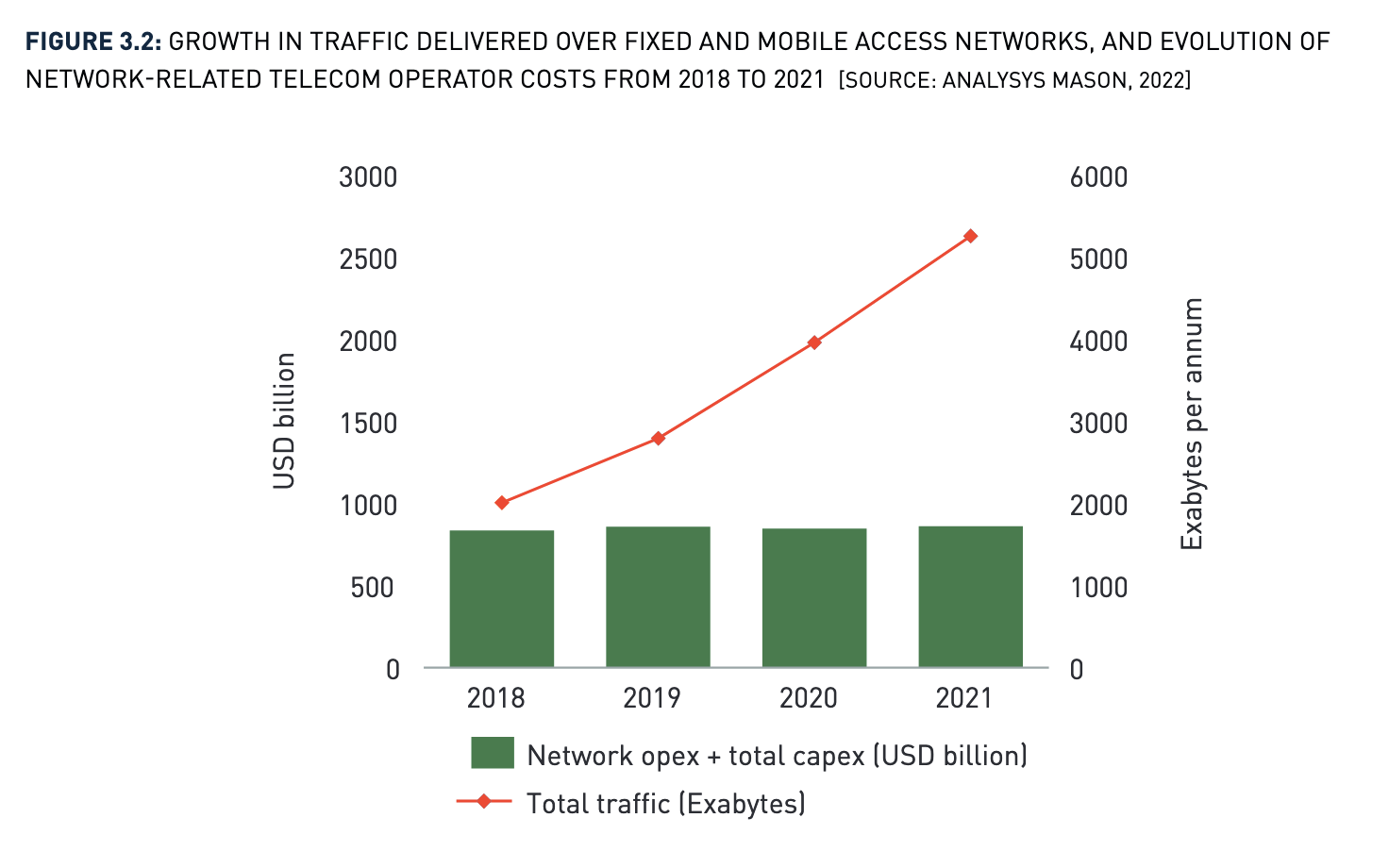Network usage fees, the idea that certain types of companies should pay internet service providers (ISPs) for the ability to deliver their content to consumers, both hurts consumers and breaks the status quo that has facilitated the rapid spread of the global internet. ISPs claim these fees are necessary because the cost for delivering internet services have increased unfairly for them. That is false. Fundamentally network usage fees are a ploy by the largest ISPs to extract monopolistic rents, kill competition, and further entrench their monopolistic power.
The European Union (EU) has been debating whether or not to adopt a network usage fee regime and will continue its deliberations in early 2023. They must be made to realize how these fees are harmful and prevented from caving to ISP pressures to adopt the regime.
What are Network Usage Fees, and the ISP Argument
The largest ISPs’ primary argument is as follows: companies that create and/or deliver information and media online, called content and application providers (CAPs), deliver their services through the physical infrastructure networks that make up the internet. Think YouTube, Netflix, and Disney+. The ISPs, who built the infrastructure (sometimes with government funds), claim they incur costs for delivering service while CAPs just get to ride the network for free. CAPs should therefore pay ISPs for delivering these services because the CAPs are freeloading off networks that the ISPs built and have to pay to maintain. If CAPs want to use the network, they should pay a fee based on how much they use, hence the term network usage fee.
The specific type of network usage fee the ISPs want is called “sending party network pays” (SPNP). To explain by example, when someone on the internet wants to watch a video, what they are doing is requesting that video be delivered to them in the form of data. The CAPs receiving that request sends that data to the person who made the request. That information has to pass through the ISP’s network to get back to the person. Because the CAPs is the ‘sending party network’ here, they must pay the ISP for what they send. That is the basis of SPNP. Additionally, if the CAPs’ information has to be sent through multiple ISPs within an SPNP regime, it needs to pay all those ISPs. Some SPNP models also want all the ISPs to pay each other when they send traffic through each other’s networks. In this arrangement the largest ISPs benefit because they already control the most extensive networks. Smaller and newer ISPs who have less extensive networks are essentially priced out of the market over time by these kinds of fees.
The ISP’s secondary argument is that the increase in internet traffic everywhere has been caused by the CAPs. CAPs like YouTube and Disney+ supposedly take advantage of infrastructure they don’t pay for to increase internet traffic throughout the world. From this framing, network usage fees are CAPs finally paying their “fair share” for using the network.
Lastly, ISPs say that money will go toward building infrastructure and expanding the physical reach of the modern internet.
How and Why the ISP Argument Completely Ignores Reality
New research from Analysys Mason finally gives us hard figures showing why the ISPs’ arguments completely mischaracterize the relationship between CAPs and ISPs. CAPs invest heavily into the physical infrastructure of the internet too. Their investments in networks save ISPs billions of dollars annually, and the costs ISPs incur for delivering traffic have not been drastically rising despite increases in traffic.
To begin, CAPs do not freeload. From 2011 to 2022 CAPs have collectively invested almost $900bn into infrastructure that hosts, transports, and delivers their services. These investments are made for the purpose of increasing the reliability and quality of their services globally, which practically means making sure their services reach consumers faster with less latency. What this looks like physically is building trans-oceanic cables to carry data across the world, data centers to bring content closer to the consumer, and caches of data that bring their services even closer. What this practically means to consumers is faster and more reliable service no matter where they are. From 2018 to 2021 CAPs spent about $120bn a year. These investments are only increasing in response to consumer usage.
From the investments CAPs have made, ISPs save anywhere from $5bn - $6.4bn annually. When CAPs bring their services closer to consumers, ISP networks do a lot less work. Instead of having to bring data thousands of miles from YouTube headquarters in California to Seoul, South Korea, an ISP can instead tap into a cache of data YouTube has placed in Seoul, South Korea itself to deliver that same data, but only across the distance of two miles. The cost difference in delivering data thousands of miles versus two miles across billions of content requests is what is saved and adds up to billions every year.
While ISPs are saving from CAPs investments, fundamentally the cost to an ISP for running a network has little to nothing to do with actual traffic going through the networks. In fact, the cost of traffic is only a fraction of an ISPs’ costs. Traffic is not sensitive to costs. One reason is that the networks themselves are built to handle high volumes of traffic. As seen from the chart from Analysys Mason’s report, despite the ever-increasing demand for internet traffic, the cost for global ISPs has essentially been stable.

The other large reason is that ISPs costs to maintain networks and deliver traffic go down as they deploy more fiber. Much of the reason why costs remain stable despite rapid annual increases in usage is due to fiber optics. As EFF has written about extensively, fiber is not only cheaper to maintain and upgrade compared to legacy infrastructure, but also has speed and traffic capacities beyond what we’ve yet been able to formally predict. As ISPs transition to more and more fiber, not only should networks get cheaper to maintain, they will also become more and more insensitive to traffic demands. In other words, the future of the internet with the right infrastructure is ever-increasing speeds at lower costs (and prices paid by users).
Network Usage Fees Harm Consumers
Network usage fees harm consumers and are a direct threat to net neutrality. The cost of network usage fees will be passed on to consumers via a more expensive internet.
Principles of net neutrality are directly threatened by network usage fees. In the instance of a CAPs’ refusal to pay, ISPs could throttle - intentionally lower the speed of service - for content a user requested. An ISP might even have the right to terminate the CAPs’ ability to send content and services to consumers, even if consumers themselves request it. ISPs who own streaming services — streaming services that would otherwise be CAPs — can also favorably prioritize their service over competitors', distorting what a consumer can and cannot watch. Net neutrality as a principle is about treating all traffic equally so the consumer can decide for themselves how they’d like their experience to be. Network usage fees take that decision away from the consumer and give it to ISPs by letting them engage in discriminatory practices to control what you can and cannot see.
Network use fees distort the market so the largest ISP disproportionately benefits to the detriment of all consumers. As EFF has written before, net neutrality and competition are necessary if we are to incentivize ISPs to do better. Without competition, ISPs can and do charge more for worse service. On the side of the CAPs, they will pass on the cost of network usage fees to consumers both tangibly as higher subscription fees and intangibly as worse service. Here too, consumers will have to deal with paying more for less.
Network Usage Fees and the European Union
The network usage fees debate is happening in the EU, and they are set to deliberate on it again in early 2023. Network usage fees were brought up and rejected in 2012 but because of incessant moneyed lobbying from the largest ISPs, the issue made a return. Fortunately, the EU telecommunication regulator, the Body of European Regulators for Electronic Communications (BEREC), released a preliminary report rejecting network usage fees and any similar interference in the market. Furthermore, small and mid-sized ISPs in Europe have come together to oppose the idea, understanding that network usage fees do not benefit them.
The outlook in the EU is currently optimistic, but we will not meet optimism with complacency. We urge the EU to once again reject the adoption of network usage fees.








